What can I say about the best places to visit in Galicia?
There are so many: the majestic ancient cities of Santiago de Compostela and Lugo, the stunning vistas of its 1030 miles (1,660 km) of coastline, its picturesque fishing villages with the freshest seafood, its dense, lush, green forests…the list goes on and on!
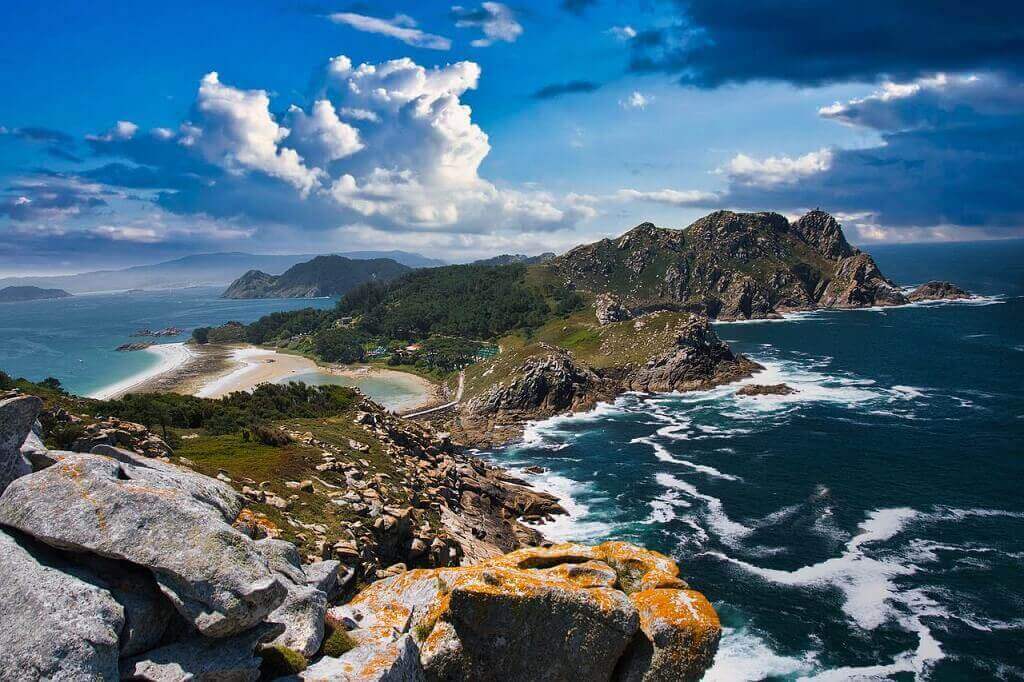
Galicia is one of Spain’s best kept secrets. This autonomous community is situated in the northwestern corner of the Iberian Peninsula, next to Asturias and immediately above Portugal.
With such proximity, it was inevitable that Galicia share its culture with Portugal although it is part of Spain.
Two official languages are spoken in Galicia, Spanish and its very own Galician language, known as Galego, a Latin root language spoken by the Romans who conquered the region in the first century CE.
Galego is spoken by about 3 million people throughout the region.
When is the best time to visit Galicia?
I visited Galicia at the beginning of the summer, just in time for some of the liveliest festivals in the region. June to September is the best time to visit Galicia as this is the driest and sunniest period.
Average temperature in the Galician summer is 72°F. Despite summer being the driest period, it’s still going to rain in Galicia -that’s why it’s so green. Travelers are advised to come prepared.
What is Galicia famous for?
Food! Particularly seafood. If you love seafood, Galicia is a must-visit destination for the freshest delicacies from the cold waters of the Atlantic Ocean as well as the Bay of Biscay.
Going on tapas crawls and exploring food markets are among the best things to do in Galicia.
Galicia also enjoys a world-renown reputation for excellent wine, the albariño, from the many vineyards throughout the region.
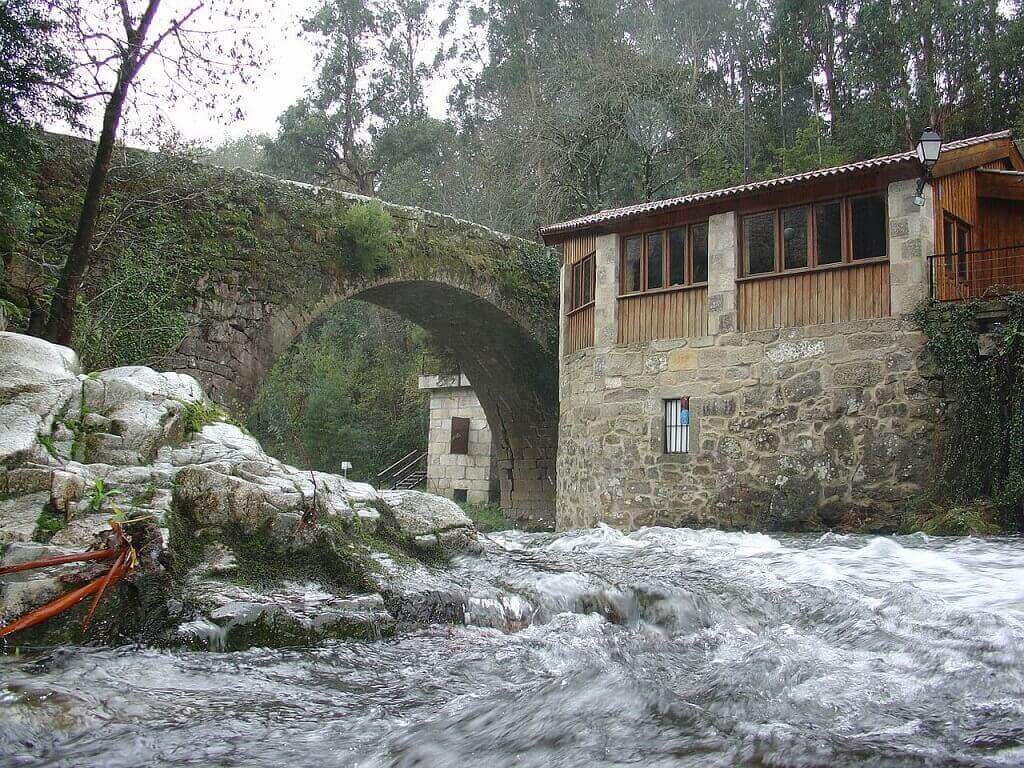
Other claims to fame include the wild, natural vistas and the historic cities of Galicia. But the region’s unique, sustainable competitive advantage is that it is the final destination of the Camino de Santiago pilgrimage.
BEST PLACES TO VISIT IN GALICIA
Table of Contents
ToggleHow to choose the best places to visit in Galicia from an endless list? We asked frequent travelers to weigh in with their recommendations.
Costa Da Morte (Death Coast)
Although the limits of this stretch of the Galician coast are not clear, it is often said that Costa da Morte covers the area between the municipalities of Malpica and Muros, a couple of villages that belong to the province of A Coruña.
This piece of paradise boasts the longest beach in Galicia, lighthouses that used to help or confuse sailors (the region took its name from the many shipwrecks that took place in that area), soaring cliffs and fishing villages.
Lovers of raw landscapes and everyone else looking to get away from the crowds will appreciate this coast because, if you dare to visit this area in winter, solitude is almost guaranteed.
You might come across locals, some surfers, and fishermen but the tourist crowds do not usually dare to come during the winter season. The possibility of rain (‘it always rains in Galicia’ is a common thought) usually stops them.
The newly opened Meiga do Mar hotel in Carnota is an excellent option for exploring the area. It has a relaxing spa, a wonderful terrace to have a drink, and spacious rooms.
What are you waiting for? Dozens of unique experiences await you in Costa da Morte, one of the best places to visit in Galicia, Spain.
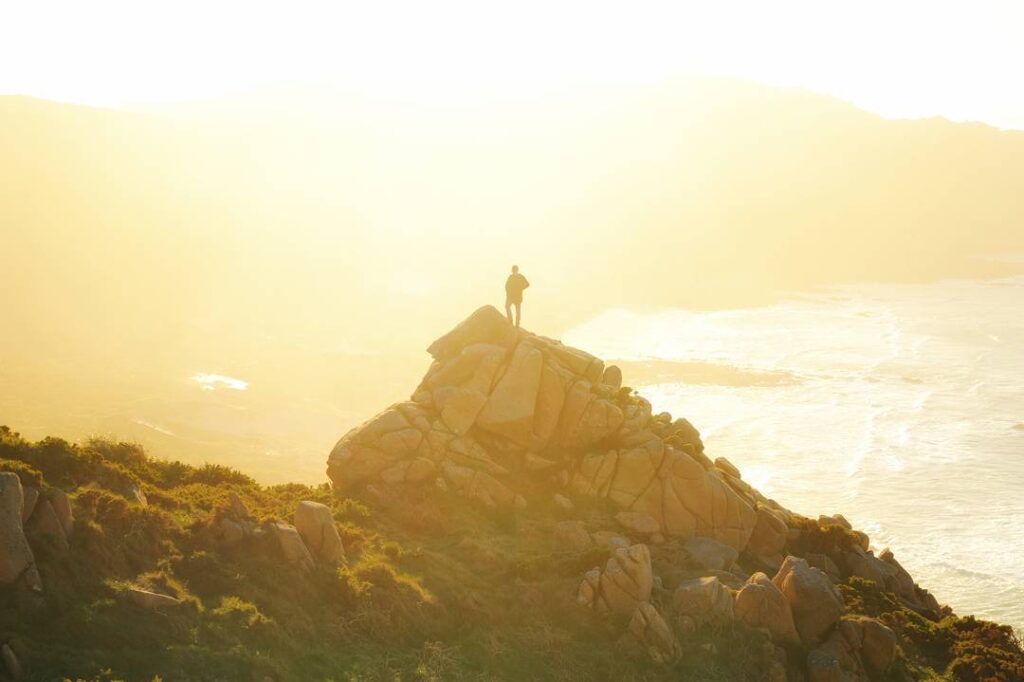
Inma blogs at A World to Travel
Love Spain? Check out HIDDEN GEMS IN SPAIN OFF THE BEATEN PATH and A 2 WEEK ITINERARY FOR ASTURIAS: NORTHERN SPAIN’S PARADISE
Santiago de Compostela
Right in the western corner of Green Spain is Santiago de Compostela, a stunningly beautiful historic city full of labyrinthine alleys, elegant squares and ancient religious buildings waiting to be explored.
Visit here as you road trip through northern Spain, and you’ll see pilgrims covering the final few miles and proudly displaying their vieira, the scallop shell badge that you’ll have seen wherever your route has coincided with the Camino de Santiago, possibly the most famous walk in the world.
The UNESCO World Heritage Site of Santiago de Compostela is undoubtedly one of the most beautiful cities in Spain and picking out the top sights can be hard.
If you only see one thing, it must be the imposing Romanesque Cathedral of Santiago de Compostela, where all roads seemingly lead, including the famous Camino.
Approach over the grand Plaza del Obradoiro for fantastic views of the frontage, before entering to admire the Gothic and Baroque interior. It’s worth the small fee to climb to the roof for panoramic views of the city.
There are lots of other attractions to see, which you should aim to pass as you wander the medieval streets and alleys of the old town, by far the best way to experience Santiago de Compostela.
Look out for the Abbey of San Martin Pinario, the second largest religious monument in Santiago after the cathedral, and Pazo da Fonseca, a delightful 16th century palace.
This patch of Spain, including Galicia, is known as Green Spain, because it rains so much! Santiago de Compostela is probably best visited in spring or September to October – to avoid both the blisteringly hot summer and the tourists that throng here when the sun shines.
Stay at the Parador De Santiago de Compostela for its unrivalled location, history, traditional decor and huge breakfast buffet!
If you have limited time, Santiago is one of the best places to visit in Galicia.
Izzy blogs at The Gap Decaders
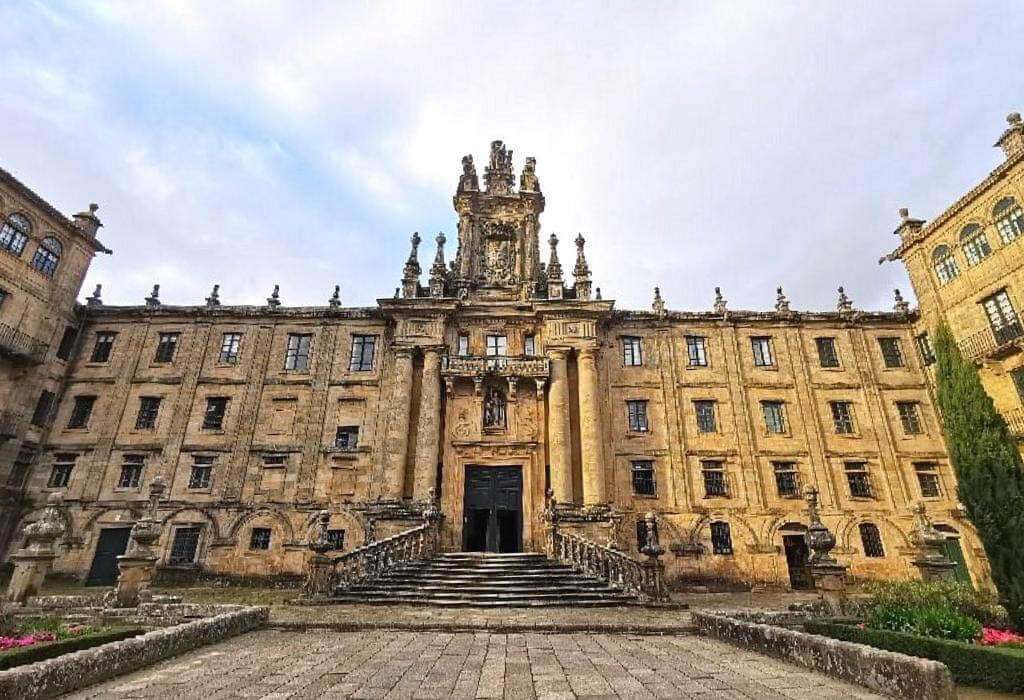
Lugo
A UNESCO World Heritage site, Lugo is an ancient city in the interior of the region, one of the most interesting cities of Galicia and arguably one of the best places to visit in Galicia.
The city lies about 60 miles east of Santiago de Compostela.
Lugo’s most outstanding features is that it is completely surrounded by its original Roman wall, one of the best preserved of the Roman Empire. In fact, Lugo is a treasure trove of Roman art.
The House of Mosaics is a well-preserved former home of a wealthy Roman and contains examples of ceramic and mosaics for the Roman period.
The nearby Roman Bridge and ancient Roman baths complete the collection of fine examples of that period. The Municipal Museum is also worth a stop to see articles from the Roman and other periods.
The people of Lugo are so into their Roman heritage that every June the populace dresses up in period costumes to perform reenactments of life under the Romans. It is one of the most important festivals of the area.
Strolling through Lugo’s Old Town is like traveling back in time. The city center boasts the Cathedral of Santa Maria completed in 1769.
If you REALLY want to travel back in time, stay at the Hotel Monumento Pazo de Orban, right next to the ancient Roman wall.
Nature lovers will appreciate the Ribeira Sacra area, a nature reserve with forests, meadows, vineyards and wineries. A day wandering – and sampling wine – at the wineries is just glorious.
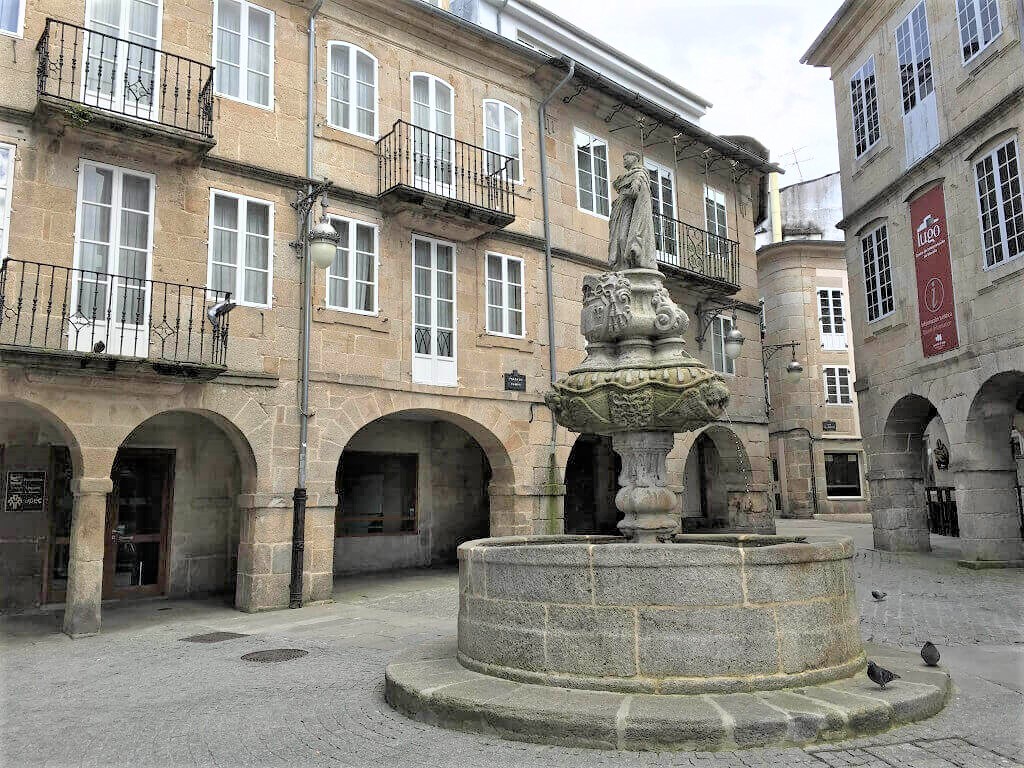
Talek blogs at Travels with Talek
Moaña
Are you thinking about visiting Galicia and getting to know its festivals, gastronomy, music, and traditional dances?
In the fishing village of Moaña one of the most important local festivals is held, the Moaña Antiqua Medieval Festival. This festival will take you back in time to live a unique magical experience from the Middle Ages!
It takes place in Moaña, Galicia, Spain in the parish of San Martiño with 2,062 inhabitants and is celebrated near the beautiful Church of San Martiño.
This is a Galician Romanesque style church from the 12th century that suffered numerous attacks by Barbary pirates from the North of Africa.
During this festival, you will find numerous arts & craft stalls, taste traditional gastronomy, listen to Galician Celtic music, and dance shows.
There will also be workshops for the little ones so they can learn about medieval writing, wood carving, coin minting, stamp sealing, etc…
You will see artisans making pieces using traditional techniques and savor the wines in the Galician taverns.
One of the most impressive shows that you cannot miss at this festival is “Errantes” performed by a group of actors called Troula Animación, which is a spectacular night-fire show.
The Concello de Moaña and the Moaña Antiqua Cultural Association are in charge of organizing this festival that is celebrated every year on June 24th, 25th, and 26th.
Apart from this festival Moaña has a lot to offer the visitor… beautiful golden beaches like the popular Xunqueira Beach, bars, restaurants, walking trails, and important cultural heritage.
So, if you want to visit Moaña during these dates and enjoy the Moaña Antiqua Medieval Festival, our Eat & Walkabout experts recommend you stay at the Hotel Bienestar Moaña located in the town centre with rooms overlooking the wonderful Vigo Bay.
For dining out we recommend the Restaurante Matices, where you can enjoy the Galician cuisine, especially tasting the amazing abundant seafood like the delicious mejillones (mussels), the star dish of this brave seafaring village!
Tiernan blogs at Eat and Walkabout
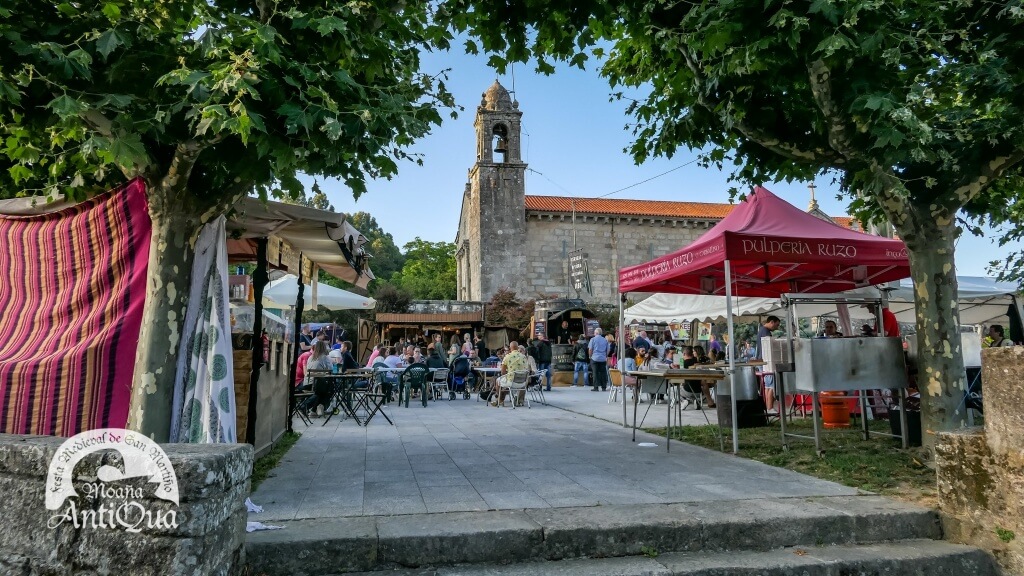
Vigo
Situated along the northwestern Spanish coastline on the banks of the Ria de Vigo, Vigo is easily one of the best places to visit in Galicia, Spain.
A dominant name in the fishing industry, Vigo is home to one of the largest fishing ports in all of Europe!
Unique to this Spanish destination, visitors can enjoy spectacular views of the grand harbor from terracotta rooftops and unlimited fresh seafood straight off the docks.
Oysters and crab are specialties, though you can find everything from spider crabs to mussels, and even barnacles! Often accompanied by a good Galician Rías Baixas wine, seafood in Vigo is at its finest.
To get there, most visitors fly to the Porto International Airport in Portugal where they will be just a quick 2.5-hour train ride from Vigo. Madrid is the next closest option with a train time of about 6.5-hours and at least one changeover.
The best time to visit Vigo, Spain is during the summer months of June and September. During this time, you’ll still experience lovely weather but far fewer tourists and better deals on flights, trains, and accommodations.
If you happen to be visiting during the month of July, you may be lucky enough to attend the Wild Festival where you’ll get to watch an amazing line-up of artists and performers from around the country including The Galician Messengers!
Overflowing with unique history and Spanish culture, Vigo is home to some of the most hospitable people in Europe. Just be sure to learn a few helpful Spanish phrases before you arrive since much of the population speaks mainly Galician and Spanish.
A perfectly located place to stay in Vigo is the Sercotel Hotel Bahia de Vigo. It is situated between Vigo Old Town and the Cies Islands’ departure pier.
Emily blogs at Emily Embarks
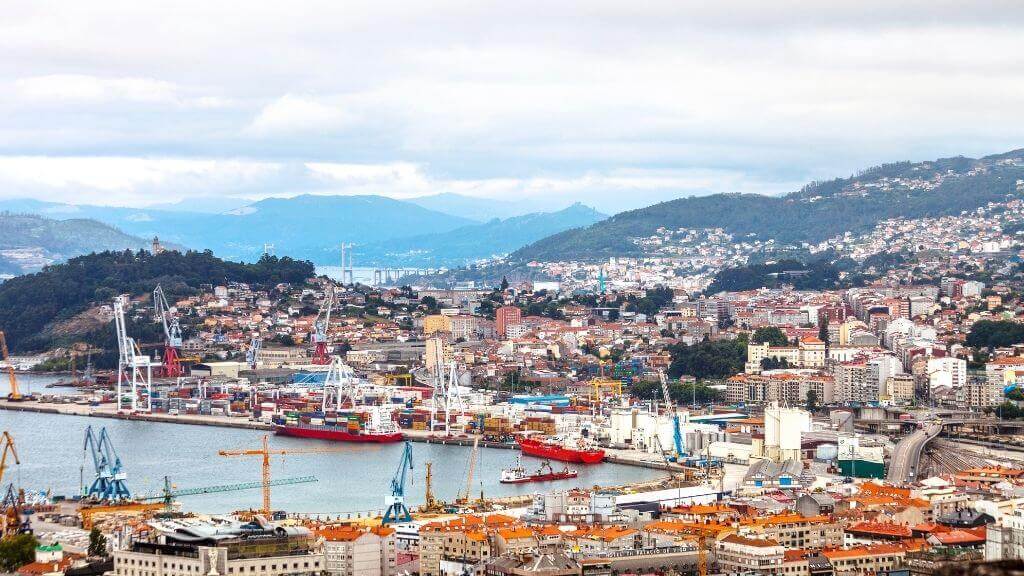
Cabo Finisterre
Cape Finisterre is a picturesque cape on the so-called Coast of Death, a part of the Atlantic Coast of Spain. It’s a not-to-miss place in Galicia.
The name “finis terrae” in the Latin language means the end of the world. In the old times, the cape was considered the end of the known world.
The scenery along the peninsula is truly spectacular; rugged rocky cliffs, sandy beaches, dramatic drops, lush-green forest, and breathtaking lookout points. Cape Finisterre is a great spot for watching the sunset.
Things not to miss at Cape Finisterre are Praia do Coveiro, Praia do Mar de Fora, Monte Facho, the Lighthouse, and Mirador Finisterre. Finisterre town is situated about 3 km away from the cape.
The city has many hotels, restaurants, and souvenir shops. Local restaurants serve freshly caught fish and seafood.
You can try traditional Galician dishes such as Pimientos de Padrón, Pulpo a la feira, steamed mussels, and tarta de Santiago.
Finisterre can be reached by bus from Santiago de Compostela. The bus journey takes 2 hours. It’s possible to walk from Santiago to Finisterre following a scenic trail. The total distance of the route is 90 km. The walk takes 3-4 days.
The summer months, June to August, are the best time to visit Cape Finisterre. When it’s nice, warm, and often sunny, it can get quite windy at the cape at any time.
The best and the most romantic place to stay in the area is Hotel O Semaforo situated in the old lighthouse building on the tip of the cape.
Alya blogs at Stingy Nomads
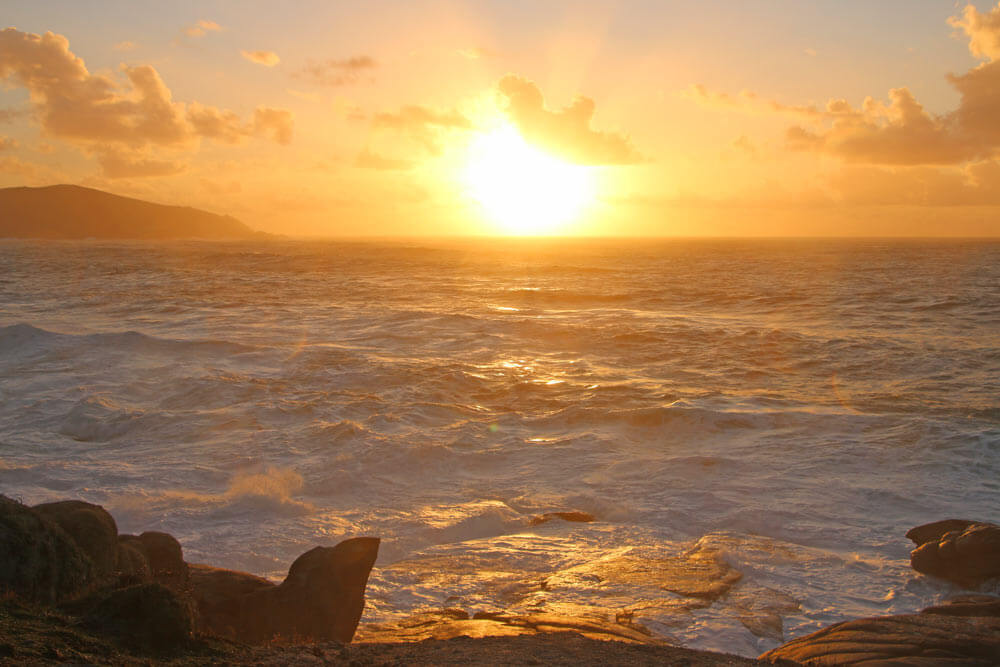
Can’t get enough of Spain? TOP 16 THINGS TO DO IN GRAN CANARIA, CANARY ISLANDS (SPAIN)
Tui
Tui is a charming hilltop village located just across the river from Portugal. The undisputed highlight of this Galician city is the magnificent Tui Cathedral which dates back to the 11th century.
The cathedral sits atop the hill and can be seen from miles in all directions.
Tui is situated in the fertile Minho River valley which has been inhabited since prehistoric times. A former Roman settlement, the city later played a key role in the wars between Portugal and Castile.
Skirmishes regularly took place between Tui and the walled city of Valença on the other side of the river.
Today Tui is an important stop on the Portuguese Camino, a historic path that leads to the pilgrimage city of Santiago de Compostela.
While many pilgrims start their journey in Lisbon or Porto in Portugal, some choose to begin walking at the Tui Cathedral. Located 116 km (72 miles) from Santiago, the distance is just long enough to earn the coveted pilgrim’s certificate.
When visiting Tui, be sure to tour the inside of the romanesque Cathedral. The tour includes a visit to the roof with spectacular views of the Minho River valley.
Other nearby attractions include the Church of Santo Domingo, the distinctive Tui International Bridge, and the beautiful medieval city of Valença just across the Minho River.
Tui enjoys mild weather year-round with temperatures reaching 78 degrees F (25 C) in the summer months and 45 degrees F (7 C) in the winter.
A great time to visit Tui is on the second Monday after Easter. This is when the city celebrates the Festival of San Telmo, the city’s Patron Saint.
There are many ideal accommodations in the area. If you’re on a budget, I recommend Residencial Portas do Sol in Valenca, Portugal, just accross the river from Tui.
For a memorable accommodation experience, stay at the Parador de Tui, part of the Paradores de España group. These are a collection of hotels established in refurbished Spanish monasteries, abbeys, palaces and hospitals.
Katy blogs at A Rambling Unicorn
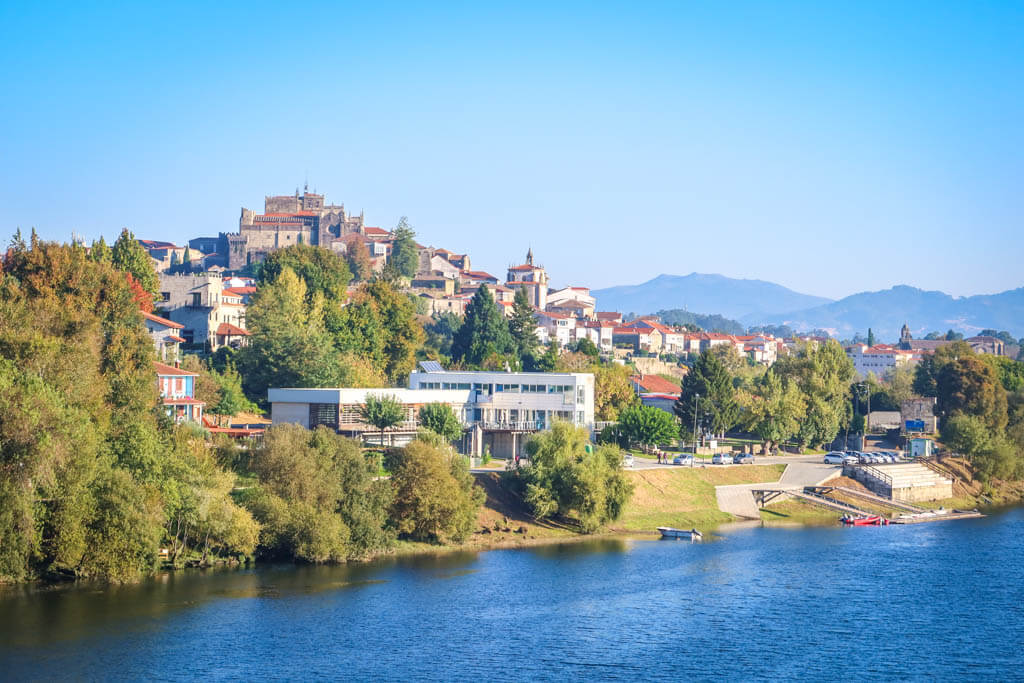
Insider tip: Want to delve deeper into Galicia’s history, cuisine, culture and traditions? Book with Eatandwalkabout.com.
This Galician group offers experiences you are unlikely to have elsewhere. Enjoy hikes in the Galician countryside, Galician cooking classes taught by native chefs and cultural tours to cities as well as coastal towns throughout Galicia.
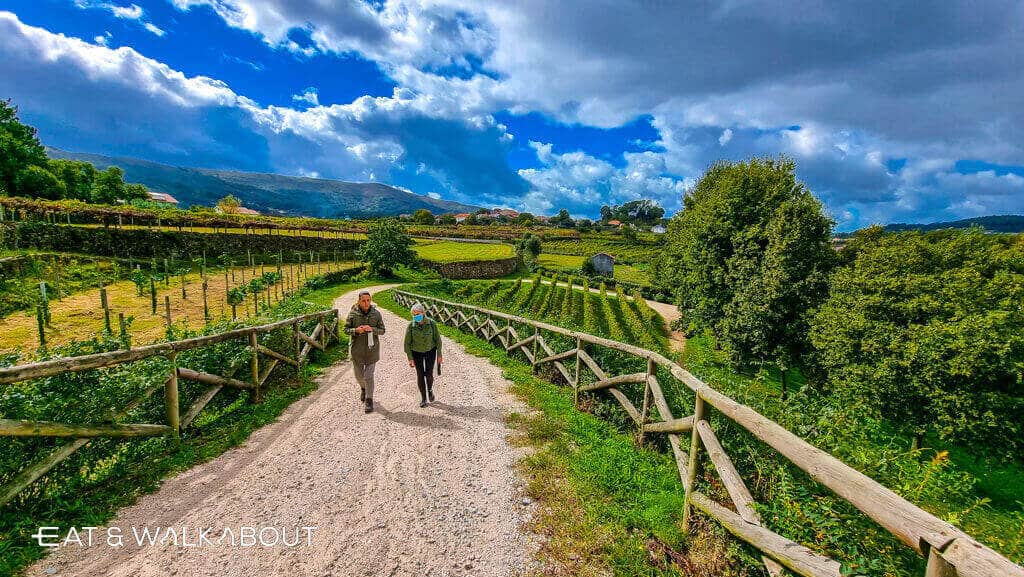
How to get to Galicia
Galicia has three international airports in Santiago de Compostela, Vigo and A Coruña. The roads are modern and easily accessible. The region is served by RENFE, the Spanish rail service and there is reliable and timely bus service.
What to eat (and drink) in Galicia
The unofficial regional dish is octopus Galician style or a Feira, served over sliced potatoes sprinkled with paprika and doused with olive oil. The tastiest Galician dessert is the Tarta de Santiago. But Galicia has many regional specialties.
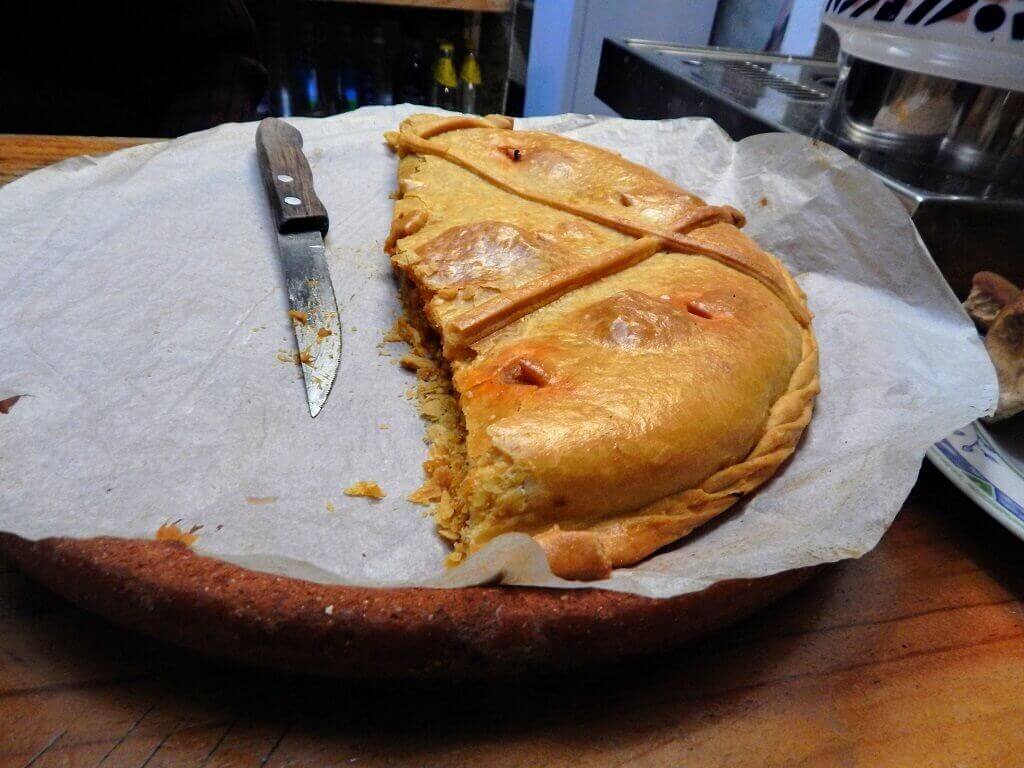

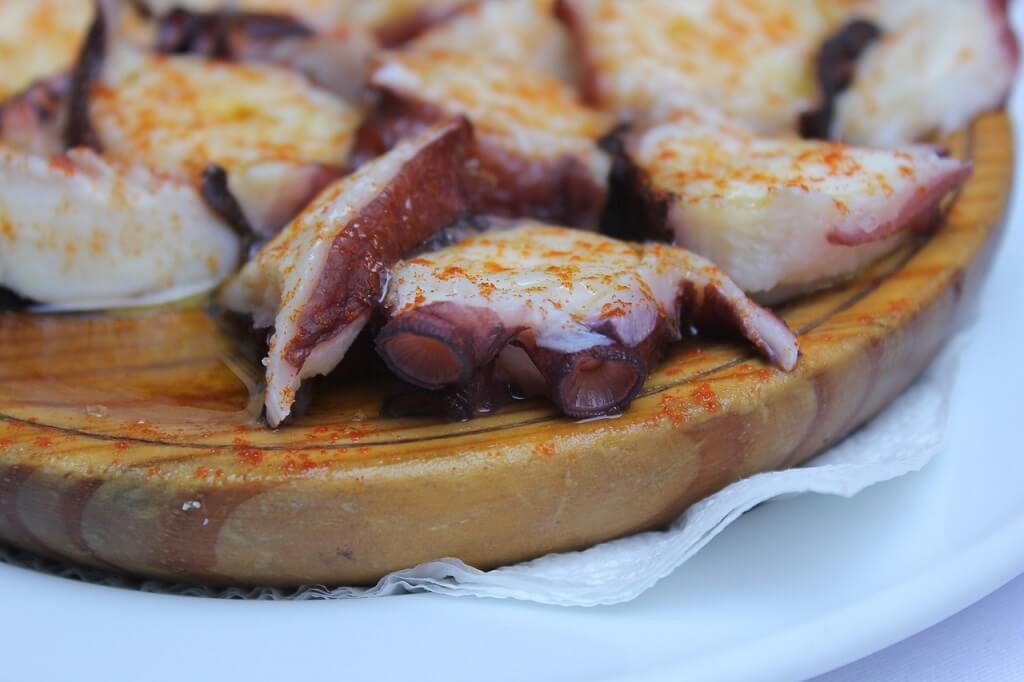
Other classic Galician dishes you should try include Galician empanadas (large meat-stuffed pastry, caldo Gallego (hearty stew with meat, beans and veggies), ternera Gallega (veal famed for its tenderness), queso tetilla (flavorful cheese, great with wine).
Here are even more delectable Galician dishes and drinks.
Galician wines are outstanding. Try the crisp, dry albariño. The excellent local beer is Estrella Galicia, widely available throughout Spain and many other countries including the United States.
If you want to experience the best of green Spain and focus on the best places to visit in Galicia, stock up on some of these reference materials.
What are our thoughts on visiting Galicia? What do YOU think are the best places to visit in Galicia, Spain? Let us know in the comments.


BTW, if you are getting ready for your trip, make sure to take advantage of these useful, money-saving links to book your trip:
- Research and book your flight with Skyscanner. I have found them to be the best because they list all airlines including the budget ones. You are always sure of having researched all options.
- For car rental around the world, Discover Cars has flexible pickup and drop-off options, I recommend Discover Cars.
- Book your accommodation with Booking.com. I find they have a wide selection and a nice, user-friendly, transparent website.
- Protect your trip and, more importantly, protect yourself with travel insurance. I use Travelinsurance.com and have been very happy with them.
- For more general tours to any destination or attraction, book with Viator. Check them out.
- Need a visa? Get your visa for all countries with Passport Visa Express.
- Looking for a cool walking tour to explore a city? My favorite walking tours are offered by Take Walks.
- Food and drink tours are the best way to enjoy a city. And Devour Tours are my favorite.
- Looking for a good VPN to protect your security, privacy and freedom online while traveling? Nordvpn is your best option.
- The best and most economical way to stay connected while traveling is with an Airalo eSIM.
I personally use, and can recommend, all the companies listed here and elsewhere on my blog. By booking through these sites, the small commission we earn – at no cost to you – helps us maintain this site so we can continue to offer our readers valuable travel tips and advice.


















